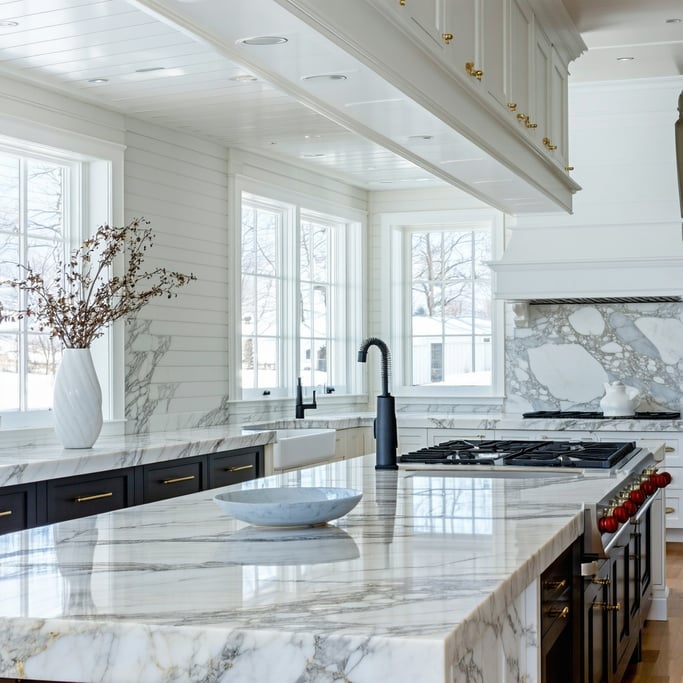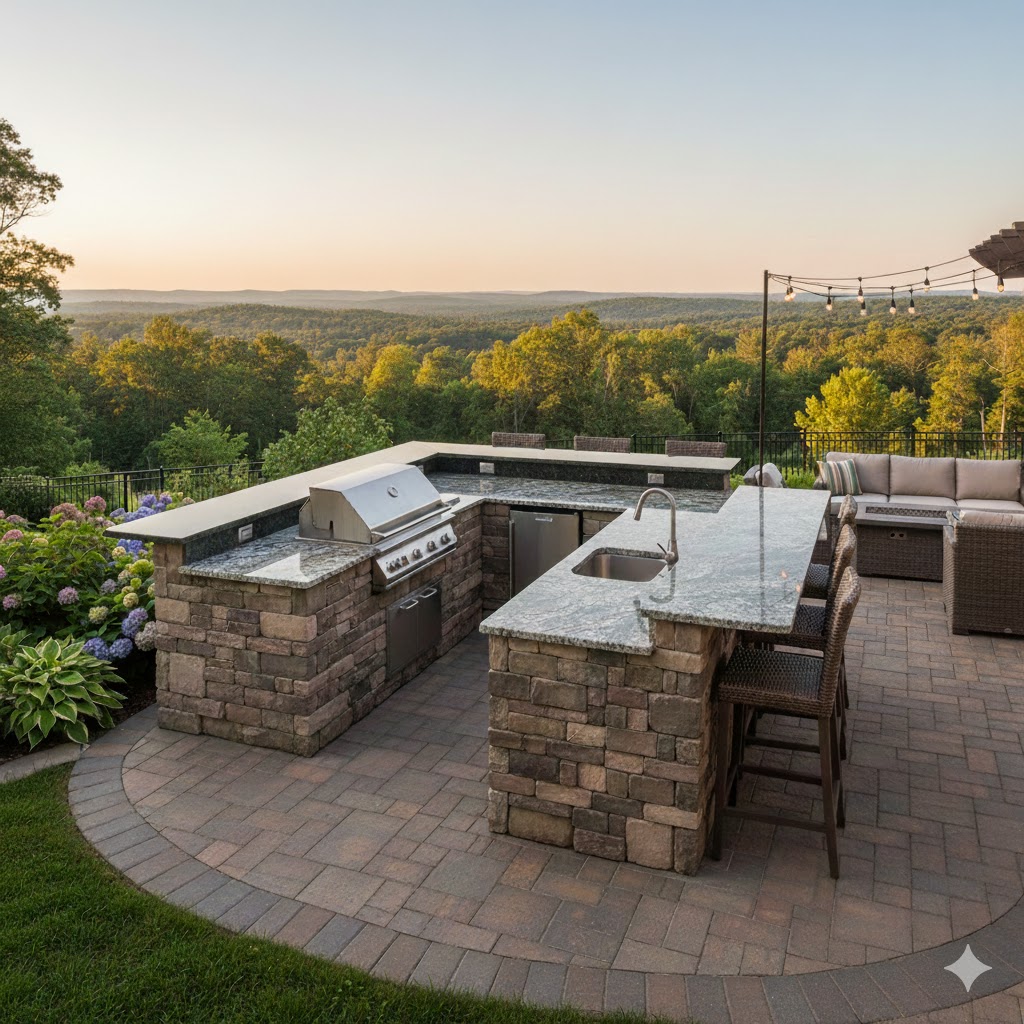Marble Countertops: A Timeline – Granite Guy Inc.

A Stone with a Long Story
Natural stone has been part of human life since ancient times. Cultures and continents used stone for early tools, food prep surfaces, temples, and tombs. Marble stood out early—not just for its strength, but for its elegance.
Ancient Egyptians used marble in tombs and temples, and in ancient Greece, marble became central to architecture and sculpture. The Romans took this legacy and made it better. They improved marble mining techniques and used it throughout their empire.
On the Aegean Sea islands of Paros and Naxos, people know Parian marble for its soft texture and pure white color. Carving with hand tools and creating straight lines is easy. Artists sculpted the Venus de Milo from it. Made mostly of calcite and calcium carbonate, white marble has long symbolized refinement, culture, and artistic achievement.
What Is Marble?
Marble is a metamorphic material formed when limestone or dolomite undergoes extreme heat and pressure deep in the ground. This transformation gives marble its signature veining and a wide range of colors—white, gray, green, pink, red, and even blue.
Different parts of the world produce distinct types of marble. People recognize Italian marble—especially Carrara marble—for its soft veining and clean white background. Brazilian marble tends to be more vibrant and crystalline. Each variety behaves differently during fabrication, which is why experienced handling matters.

Marble Through History
Marble use expanded during the 6th to 4th centuries BC. Builders constructed temples like the Parthenon and the Temple of Olympian Zeus from marble blocks. Workers used simple tools to extract and shape the marble. Despite the limitations of the time, ancient craftsmen achieved incredible precision.
As marble production increased, the Romans improved quarrying and marble export. They made the material a common commodity.
They added new colors to the mix. These include green marble with serpentine, pink marble, and deep red marble. These marbles are for palaces and public buildings.
The Renaissance marked another peak in marble’s popularity, especially for sculpture. Michelangelo carved his famous David from Carrara marble.
Ancient Civilizations and Marble
For the Greeks and Romans, marble wasn’t just a building material—it was a symbol of power, culture, and art. The Greeks used white marble extensively in temples, sculptures, and public buildings. The Romans followed suit and expanded its use into homes, palaces, fountains, and gardens.
Egyptians used it in tombs, while in India, white marble famously defined the Taj Mahal. Over time, marble’s symbolic role extended into European churches and cathedrals, especially during the Renaissance and Baroque periods.
History of Marble Quarries
Quarrying started in the Aegean Sea. Islands like Paros and Naxos provided large amounts of Parian marble to ancient civilizations.
Workers mined marble by hand. They used chisels, hammers, and simple lifting systems. The Romans made these techniques much better. This made it easier to cut, move, and share marble.
Carrara, Italy, soon became a center of marble production. In present day, countries like Italy, India, Turkey—and even the U.S.—lead the global supply.
Vermont’s Danby marble, Georgia White, and Calacatta Lincoln from Colorado are top examples of American marble. Manufacturers now use recycled marble dust in materials like paint, adding a sustainable angle to modern production.
Cultural Significance of Marble
From temples to tombs, and palaces to modern hotels, marble has always been associated with wealth, beauty, and permanence. Its light-reflecting surface, sculptability, and smooth texture make it ideal for both artistic and structural use.
In modern buildings, architects still use marble in luxury homes, resorts, and public landmarks. It brings history and elegance to today.
Marble in Architecture and Homes
As early wooden structures deteriorated, marble became the preferred material for permanence. It eventually made its way from public temples into private estates and upscale homes.
In 19th-century Europe, it became common in kitchens, bathrooms, entryways, and even fireplace surrounds. Today, we work with clients in places like Wellesley, Concord, Cape Cod, and Marblehead. Here, marble still looks great with historic New England buildings.

Marble countertops became popular in the early 1900s, especially in high-end homes and bakeries. They fell out of fashion during the laminate and ceramic boom, but never fully disappeared.
Today, kitchen countertops made from marble are once again in demand—for good reason. They’re elegant, timeless, and naturally cool—perfect for baking and brightening a room. For homeowners who have raised their families, marble is often the top choice for their dream kitchen.
Not as hard as granite, quartzite, or porcelain, but not fragile either. When installed and maintained properly, it holds up beautifully.
Design Options for Marble Countertops
Marble is surprisingly versatile. You can choose from finishes like polished, honed, leathered, or the DALL finish for a more refined, classic feel. We often recommend honed or leathered marble for kitchens—they're more forgiving with etching and age beautifully.
Edge profiles range from straight to traditional ogee. Popular varieties include Calacatta for bold veining and Parian marble for smooth carving detail.
You can choose between a mix of stones or a single color with marble. It fits many styles, from modern minimalism to classic charm.
// Another Fun Fact: According to Marble and Granite’s post, Danby Marbles have an absorption rate between .
https://www.renovationhusbands.com/post/our-danby-marble-countertops-two-months-in
Benefits of Marble
Marble is known for its heat resistance, beauty, and timeless appeal. Its smooth surface and cool temperature make it ideal for cooking and baking prep, especially when you want dough to stay firm.
Soft, yes—but not delicate. With proper sealing and some awareness (no lemon juice spills left overnight), it holds up for decades. It develops a patina that tells a story rather than hiding it.
Installation and Cost
Installing marble is a hands-on process: templating, cutting, polishing, and fitting each piece carefully. But not all marble is the same. Some varieties are softer, others more prone to chipping or etching.
At Granite Guy Inc., we understand how to handle different materials. Each stone gets the attention it deserves. That’s what sets our fabrication process apart.
Costs vary. Most marbles fall between $40 to $100 per square foot. Rare options—like blue, pink marble and Calacattas can go over $200 depending on complexity and yield.
Preservation and Maintenance

Most people think sealing protects marble from everything, but the real issue is etching. Calcium mostly composes marble. This means that anything acidic can harm it.
Examples of acidic things are vinegar, wine, and lemon juice. Even a wet glass can dull the surface.
Sealing helps with stain resistance but won’t prevent etching.
Newer technologies, like clear protective films and thin epoxy coatings, add extra defense. But we still recommend choosing a honed or leather finish. It hides wear better and stays beautiful longer—especially in busy kitchens and bathrooms.
To clean it, just use mild soap and warm water. Avoid abrasives, bleach, or acidic cleaners.
Final Thoughts: The Allure of Marble

Marble isn’t just another countertop material. Part of a legacy that spans thousands of years.
Many of our clients want a "forever kitchen." For them, marble is the finishing touch. It brings everything together.
Beautiful, functional, and deeply tied to history. No other material blends art and architecture like it.
Frequently Asked Questions About Marble Countertops
-
What makes marble different from other countertop materials?
Marble is a metamorphic stone formed from limestone or dolomite under intense heat and pressure. It is known for its beautiful veining, many colors, and cool surface. This makes it great for baking and classic design. -
How has marble been used throughout history?
Marble has been a favorite for thousands of years, from Egyptian tombs and Greek temples to Roman palaces and the Taj Mahal. Today, it still shines in upscale kitchens and historic homes. -
Where does marble come from?
Marble is sourced from around the world. Top producers are Italy, Brazil, India, Turkey, and the U.S.Some notable American brands are:
- Danby from Vermont
- Pearl Grey from Georgia
- Calacatta Lincoln from Colorado
-
Why is Carrara marble so popular?
Carrara marble is loved for its soft gray veining and crisp white background. It’s been used in iconic works like Michelangelo’s David and remains a go-to for elegant interiors. -
Is marble fragile or high maintenance?
It’s softer than granite or quartzite but not delicate. With proper sealing and by avoiding acidic spills, marble stays beautiful and develops a rich patina over time. -
What are the best finishes for marble countertops?
Honed and leathered finishes are top picks. They hide etching and wear better than polished surfaces—especially in busy kitchens. -
Is marble a good choice for kitchens?
Definitely. Marble stays cool, making it perfect for prep and baking. Many homeowners choose it for its elegance and long-term charm. -
How much do marble countertops cost?
Most marble falls between $60 and $150 per square foot . Rarer types, like blue, pink, and Calacatta marble, can cost over $200. The price depends on the stone and the amount needed. -
What’s the best way to clean marble countertops?
Use warm water and mild soap. Avoid acidic cleaners, bleach, and abrasives. Sealing helps resist stains but won’t stop etching from acidic liquids. -
Do I need to visit the showroom to choose marble?
Yes—we always recommend it. Marble should be seen and felt in person. Visit our showroom to view full slabs and discuss options with our expert team.
Granite Guy Inc. is located in Southborough, Massachusetts, on Route 9. We serve Greater Boston, MetroWest, and Central Massachusetts. We are also happy to travel across New England for the right project.
Marble is something you absolutely have to see and feel to fully appreciate. Come explore full slabs, get a feel for the finishes.
You can call us at (508) 460-7900 to get started.


